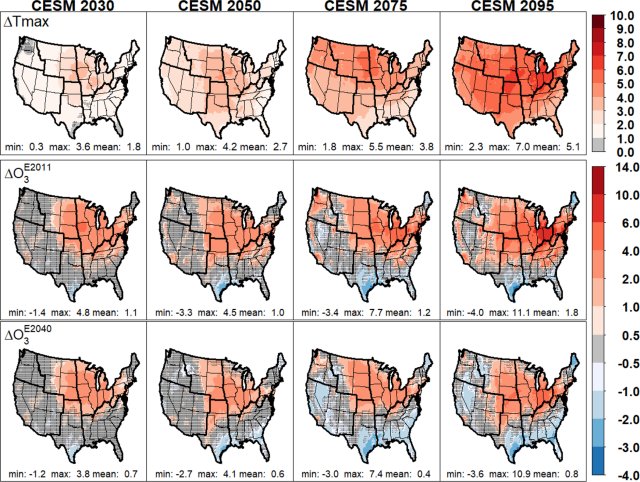Air Quality and Climate - CMAQ
The air we breathe and its interactions with pollutants is impacted by climate. Changes to temperatures, rainfall, clouds, wind patterns, and humidity will impact chemistry in the air and near the ground.
Regional climate can be simulated by using outputs from global climate models to drive a regional meteorological model, such as the Weather Research and Forecasting model (WRF), using a process known as "dynamical downscaling". Together with a projected emissions scenario, the dynamically downscaled meteorology can be used with CMAQ to simulate future air quality.
Dynamical Downscaling with WRF
- Dynamical downscaling uses a physics-based model (here, WRF) to create a finer-resolution evolution of the local weather that could occur with climate change.
- The datasets used with CMAQ are from the EPA Dynamically Downscaled Ensemble (EDDE). A subset of the EDDE datasets is available on Amazon Web Services via the Open Data Project.
- WRF is set up differently for regional climate than it is for historical meteorological simulations for CMAQ.
- Validation of downscaled WRF for future scenarios uses different methods than for historical simulations because there are no observations available for the future.
Simulating Future Air Quality with CMAQ

- CMAQ is run similarly for climate change applications as it is for historical (retrospective) studies.
- One area of active research is the development of methods to link projections of future wildfire incidences and area burned with WRF and CMAQ to simulate resulting impacts on air quality and human health.
- Future air quality simulations from CMAQ have been used for health analysis with a variety of tools, including EPA’s Benefits Mapping and Analysis Program (BenMAP).
Related Links
- Projecting Changes to Human Health with CMAQ
- Weather Research and Forecasting (WRF) Model
- EPA’s Benefits Mapping and Analysis Program (BenMAP)
- General Information about EPA Dynamically Downscaled Ensemble (EDDE)
- Accessing EDDE Datasets
References
Campbell, P.C., J.O. Bash, C.G. Nolte, T.L. Spero, E.J. Cooter, K. Hinson, and L.C. Linker, 2019: Projections of atmospheric nitrogen deposition to the Chesapeake Bay Watershed. Journal of Geophysical Research: Biogeosciences, 124, 3307-3326. https://doi.org/10.1029/2019JG005203
Dionisio, K.L., C.G. Nolte, T.L. Spero, S. Graham, N. Caraway, K.M. Foley, and K.K. Isaacs, 2017: Characterizing the impact of projected changes in climate and air quality on human exposures to ozone. Journal of Exposure Science & Environmental Epidemiology, 27, 260-270. https://doi.org/10.1038/jes.2016.81
Fann, N., C.G. Nolte, P. Dolwick, T.L. Spero, A. Curry Brown, S. Phillips, and S. Anenberg, 2015: The geographic distribution and economic value of climate change-related ozone health impacts in the United States in 2030. Journal of the Air & Waste Management Association, 65, 570-580. https://doi.org/10.1080/10962247.2014.996270
Fann, N., T. Brennan, P. Dolwick, J.L. Gamble, V. Ilacqua, L. Kolb, CG Nolte, T.L. Spero, and L. Ziska, 2016: Ch. 3: Air Quality Impacts. In: The impacts of climate change on human health in the United States: A scientific assessment. US Global Change Research Program, Washington, DC, pp. 69-98. https://doi.org/10.7930/J0GQ6VP6
Otte, T. L., C. G. Nolte, M. J. Otte, and J. H. Bowden, 2012: Does nudging squelch the extremes in regional climate modeling? J. Climate, 26, 789–804. doi:10.1175/JCLI-D-12-00140.1.
Seltzer, K. M., C. G. Nolte, T. L. Spero, K. W. Appel, and J. Xing, 2016: Evaluation of near surface ozone and particulate matter in air quality simulations driven by dynamically downscaled historical meteorological fields. Atmos. Environ., 138, 42–54. doi:10.1016/j.atmosenv.2016.05.010.
Spero, T. L., C. G. Nolte, J. H. Bowden, M. S. Mallard, and J. A. Herwehe, 2016: The impact of incongruous lake temperatures on regional climate extremes downscaled from the CMIP5 archive using the WRF model. J. Climate, 29, 839–853. doi:10.1175/JCLI-D-15-0233.1.
Nassikas, N., K .Spangler, N. Fann, C.G. Nolte, P. Dolwick, T.L. Spero, P. Sheffield, and G.A. Wellenius, 2020: Ozone-related asthma emergency department visits in the U.S. in a warming climate. Environmental Research, 183, 109206. https://doi.org/10.1016/j.envres.2020.109206
Nolte, C.G., P.D. Dolwick, N. Fann, L.W. Horowitz, V. Naik, R.W. Pinder, T.L. Spero, D.A. Winner, and L.H. Ziska, 2018a: Air Quality, In: Impacts, Risks, and Adaptation in the United States: Fourth National Climate Assessment, Volume II. [Reidmiller, D.R., C.W. Avery, D.R. Easterling, K.E. Kunkel, K.L.M. Lewis, T.K. Maycock, and B.C. Stewart (eds.)]. US Global Change Research Program, Washington, DC, pp. 512-538. https://doi.org/10.7930/NCA4.2018.CH13
Nolte, C.G., T.L. Spero, J.H. Bowden, M.S. Mallard, and P. Dolwick, 2018b: The potential effects of climate change on air quality across the conterminous U.S. at 2030 under three Representative Concentration Pathways, Atmos. Chem. Phys., 18, 15471-15489, doi:10.5194/acp-18-15471-2018.
Nolte, C.G., T.L. Spero, J.H. Bowden, M.C. Sarofim, J. Martinich, and M.S. Mallard, 2021: Regional temperature-ozone relationships across the U.S. under multiple climate and emissions scenarios. Journal of the Air & Waste Management Association, 71, 1251-1264, https://doi.org/10.1080/10962247.2021.1970048
Wilson, A., B.J. Reich, C.G. Nolte, T.L. Spero, B. Hubbell, and A.G. Rappold, 2017: Climate change impacts on projections of excess mortality at 2030 using spatially varying ozone-temperature risk surfaces. Journal of Exposure Science & Environmental Epidemiology, 27, 118-124. https://doi.org/10.1038/jes.2016.14
